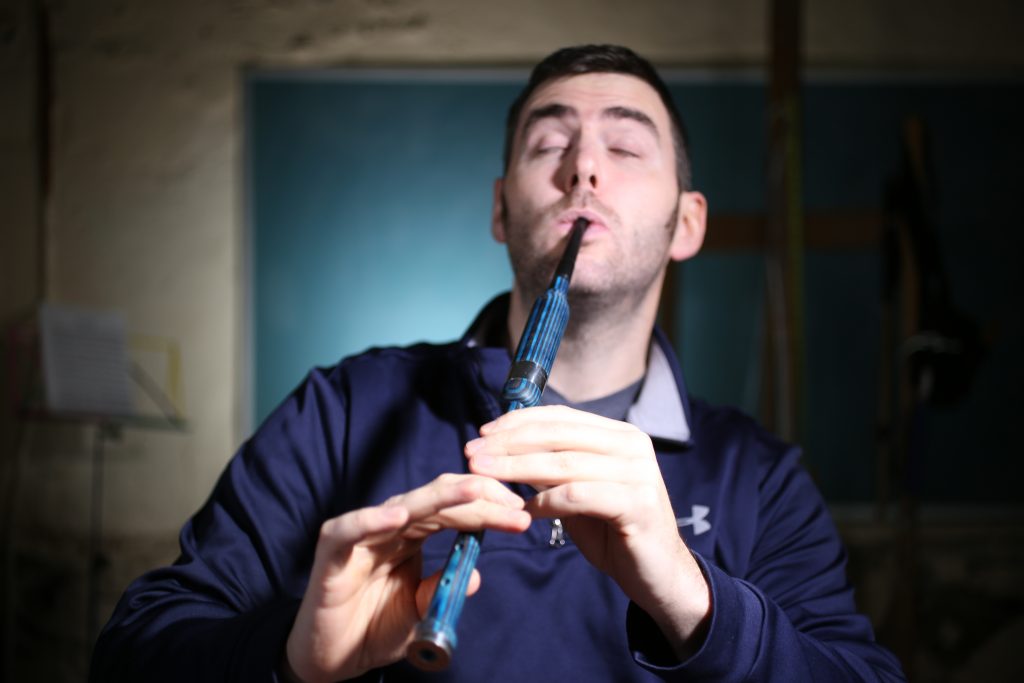Why Tuning Is Not Enough - Foundations of Great Bagpipe Sound

Don’t you just love the sound of a beautifully tuned bagpipe? The full harmonic sound of the drones blended perfectly with the chanter notes. Are you amazed how professional pipers seem to tune easily and get that steady full sound? What if I told you that it’s not just about good tuning?
Andrew walks us through the 13 steps of achieving great bagpipe sound. Tuning is only one part of this process. Without the foundational steps outlined here, your bagpipe tuning will haphazard at best.
Listen to This As a Podcast
Click here now to listen to this as a podcast.
Find the Piper’s Dojo Audio Experience podcast on Apple iTunes, SoundCloud, Spotify, Google Podcasts -- or wherever you listen to your podcasts.
Video Transcription:
All right guys, let's go through the 13 steps of a great bagpipe sound here. This is a review, so something we need to think about on a regular basis. So go ahead, what are they?
By the way, if you're not sure what the 13 steps of bagpipe sound are, a good first step would be, what are the three categories? Let's start with three categories in order of great bagpipe sound. What are the three categories?
Good, maintenance is the first one, right? Maintenance is the foundation on which everything else is built. Then what? Tina says, "Tone." Can we be more specific? Yeah, I like tonal quality better because it suggests that there are different degrees and that we are aspiring for the highest possible degree of tonal quality.
Good, and the final category, tuning. I like that. Three categories of bagpipes sound. And each one is built upon the previous. Okay, so we can't have good tuning if we can't control our instrument and produce excellent tonal quality. All right, and we can't have excellent tonal quality if our bag pipe is leaking.
Okay, we're not going to be able to control something that has a bunch of leaks in it. Just like you can't control the quality of the air inside of the space shuttle if the space shuttle has a bunch of holes in it.
Okay, three categories of bagpipe sound, pretty basic right? Now, inside of each category we've got the actual steps. So what are the four steps of bagpipe maintenance? Good. Is my bag airtight? That's the most basic thing.
Okay, number two. Good, joints airtight. Now, you are more than welcome to do the tuning slides as part of step two if you want. But I want to be really clear, it is not an essential question of bagpipe maintenance. Keep this really simple.
As soon as you're like, "Well, you know, I want to wrap one unwaxed string of hemp with my waxed string of hemp in order to get my joints air tight," you know what I mean? Sure. You could do that. And obviously if we play in a band or if we have any interests in our drone staying in tune, we obviously, we need to hit those tuning pins.
But the purpose of the maintenance questions is specifically to make sure that there's what, makes sure what is true about our instrument? Efficient, what does that mean? Boil it down to me in language this simpleton can understand. What's efficiency mean?
No leaks, no leaks. I would wear my bagpipe to outer space. No leaks, okay. Number three, reed seats. Reed seats is one of those ones that tons of people screw it up. All right. Easy drones, they come with that little rubber sleeve around the reed, right? And, and you should be able to plug that rubber sleeve into your bagpipe. You don't even have to do anything and then your easy drones will work.
Yes, it's true they will work. But are you reed seats 100% fail safe? No question about it, air tight with those rubber sleeves? No, especially if for any reason they get jarred loose, something like that. You're just asking for trouble and you're asking for leaks.
That's why we cut the rubber sleeves off and put hemp on them, so that we can get that really nice seal and that no air is leaking through. And then the final question of bagpipe maintenance is drone reeds calibrated. All right, now what should they be calibrated to? They should be calibrated to the strength of the chanter reed.
Okay. And for nerds, right? If you're a perfectly steady blower, your drone reeds should be calibrated to what? To the sweet spot of your chanter reed. On the assumption most of us are not perfectly steady blowers, we calibrate our drone reeds as close to the sweet spot as we possibly can, while compensating for deviations in pressure, right?
If you're a nerd, we want to calibrate the drone reeds to the sweet spot. But of course, reality sets in and we're going to have some fluctuations up and down. So we need to make sure if we accidentally fluctuate up, our drone reeds don't shut off, right?
But interestingly, the steadier you are as a blower, the more efficient your bagpipes can become. And that does it for the maintenance. What's beautiful about this wonderful system that we have, I wouldn't say that we invented it, but we sort of discovered it, right? We discovered the best way of talking about it. What's beautiful about this is there really are only four things that you need to do to make sure your bagpipes are operating at a high level.
For example, the day of the World Pipe Band Championships and all the days leading up to it, what do I do to make sure my bag pipe is ready to go win the world championships? I just do the four questions each and every day. This is it. There's no more. You've got lots of little options inside of these four things that you can do i you want.
You could play a synthetic bag, you could play a sheepskin bag. You could use Robertson's seasoning, you could use air tight seasoning. You could use a water trap, you could use Teflon tape. You could mix unwaxed hemp with waxed hemp if you want. I have no idea why people want to do that. What else could you do? You could do tuning slides. You can use a Teflon tape on the tuning slide, so if you tune them in one direction, they go up and if you tune them the other direction, they go down because you've trained the grain of the Teflon.
What else? I don't know, whatever, like there's all this stuff. Oh, you could use cobbler's wax at the base layer of your hemping of the joints and then add in a different type on top. What kind of other weird ass things do people do? I don't know.
Okay, but as long as one, two, three, four is yes, then we're good to go. Everybody understand that? I'm already sidetracked. Do not give into the temptation to make it more complicated than that.
Now, the next category is tonal quality and there are three components to producing amazing tonal quality. "What are the three components," is what Jen says. Find the sweet spot, otherwise known as identifying what pressure produces the best quality of timbre. Steady blowing, very important, but it's actually a secondary priority. This is a big thing. This is something that most of the world has wrong.
Steady blowing is not a top priority. It's a secondary priority. The top priority is identifying at what pressure our channel reed sounds the best. Let me give you an example. I'm going to blow my practice chanter perfectly steadily for you. Ready?
Wow. Wow. Listen to that steadiness. Did you guys hear my steadiness there? Oh my God, I was so steady. But guys, my teacher told me I have to blow steadily, so I just did. I was so steady. Oh my God. My manometer, the water in my manometer, it didn't even move. It stayed perfectly steady. I am a master of steadiness. I'm the best.
I'm going to put out my shingle and start selling bagpipe lessons. Fire up a quick YouTube channel. Give a dojo a run for its money. You know what? I'm going to pimp this thing out a little bit. Put some fire on my drones.
So good, the actual point being, blowing steadily is a secondary priority. The top priority is identifying where our reed sounds the best. And what reed are we talking about? Are we talking about drone reeds or the chanter reed?
Good. We're talking about the chanter read. Why; because the drone reeds need to be set to the strength of our chanter reed. It's not really the other way around. Drone reeds sound the best when they're perfectly calibrated, when they're taking the minimum amount of air, right? The balance is the volume, right? They're not too open, producing tons of volume and they're not to open just producing that very raw, buzzy kind of open sound.
So we're really talking about the chanter reed here and every chanter reed has its own sweet spot. As a matter of fact, at any given time, a chanter reed's sweet spot is different than an any other given time because there's a variety of factors at play, right? Presumably, amount of moisture in the system, age of the reed, ambient temperature, temperature inside the bag. Really the sweet spot is like, it's something that you need to be able to feel and identify.
Okay, irregardless, step five, identify the sweet spot. What is the sweet spot? What is the definition of the sweet spot? No jokes, no squeals, place. Tina, that's just you've been here so long, you need to be able to do better than that.
Good. The maximum pressure without producing any unwanted sounds. Okay. The idea being, the more energy we can put through that reed, the better because it's going to allow for more and more vibration of that reed. Okay?
So the more energy we can put through it, the better. Just like the more energy we can strike or bow a string on a stringed instrument, the more vibrant, maybe more volume, but the more vibrant that's going to be, versus if you just barely scraped the string with the bow, it's not going to get a great tone. But the more energy we can put through it, the better.
But then we know there's a limit to how much energy we can put through the reed. We have to figure out just how far we can push the reed without anything bad happening. And that is the sweet spot you can and should probably use a manometer to help teach you the basics, but at the end of the day you don't need it.
At the end of the day, what I'm generally trying to do is blow as hard as I can, flirting with the line where things start to sound unpredictable or a little bit gross or a little bit distorted. I'm always trying to ride that line to see how far I can go with the reed and then you develop a feel for it over time.
It's not the pressure just before the reed cuts off. A bagpipe chanter reed is never going to cut off or if it does, it has to be at an extraordinarily high pressure, so it's going to be the pressure at which it starts to squeak or squawk or become distorted.
All right, now, once we've identified the sweet spot, then what's our next priority? Then we want to blow steadily at that sweet spot. Okay, and there are two dimensions to steady blowing.
What are the two dimensions? The first one is a prerequisite to the second one and we call this physical blowing mechanics and we obviously want to be steady with our physical blowing mechanics. What does physical blowing mechanics mean? Physical blowing mechanics means we can blow, squeeze and transition steadily.
We can blow, transition, squeeze, transition, blow, transition, squeeze, transition. We can do that with no significant deviation in pressure, whatsoever. That's a very difficult thing to do, but it's made a lot easier by all of the previous fundamentals being in line.
Then what do we do? What's the second dimension of steady blowing? Good. We want to eliminate mental blowing anomalies. Good. Give me an example of a real world mental blowing anomaly. Give me some from our recordings that we hear each and every week at the dojo. What's a mental blowing anomaly we hear every single week? Good. A surge on a high A is a perfect example.
Why do we surge on high A, but no other notes? I'm not sure, but it's extremely common. All right. It's so common that people have invented random myths to justify why it happens. But one thing's for sure, Stuart Little doesn't have any of those. I don't have any of those, [Callen Beaumont 00:00:14:17] doesn't have any of those, Matt [McIser 00:14:19] doesn't have any of those.
We think you have to get to that high pitch. No, that's probably not it. I think what it is, is we have to let go with our left hand in order to play a high-A. And because it's our squeezing arm, it causes a reflex. So it has to do with players who have to develop better posture and/or loosen the grip on the left hand. That's my experience. That's my hypothesis about why that happens.
Sure. I mean, anything that causes your bagpipe to be too hard is going to contribute to these a steady blowing issues. Of course, Sally, yeah, but it may or may not have anything to do with it. What a mental blowing anomaly is though, is it's something that is in our heads, okay, that doesn't have to do with physical blowing mechanics.
It has to do with something our fingers are doing that's causing a mental reaction negative to the blowing process, and you have to play that pressure for the entire scale regardless of what you're playing. And just awareness of what you're trying to do is so important. So you can use a manometer, I highly recommend it. It's a great tool to help illustrate some of these things, but you don't need it.
Just like a metronome is a great, great, great, great, great, great tool for developing a good sense of timing and developing rhythmic accuracy, but you don't need it. But yeah, there's a great manometer workshop on the site. Is it still there? Is it called the manometer experience?
And then once we've achieved this amazing tonal quality, then we go into the world of tuning. And it's not that you need to be a master of five, six and seven in order to start the process of tuning your pipes and learning how to tune. Okay? But you will never get yourself exceptionally well in tune without a mastery of five, six and seven. Which is ironic because most people, what they want to do, is learn how to tune and I really like that. As you know, we have a whole tuning clinic. We have that whole thing that we do.
That's all great. Tuning is important, but it's not going to happen, right? A high degree of tuning mastery is not going to happen without one through seven really, really well in place. So we can learn the basic mechanics of tuning. But remember that tuning is a result of excellent prerequisites. That's what puts us in the position to be able to tune.
Try a Dojo U Premium Membership for $1
Enjoying this content and want to try Dojo U? Try our Premium Membership for a full month for just one dollar by clicking here now!






Responses